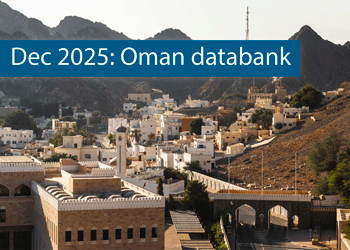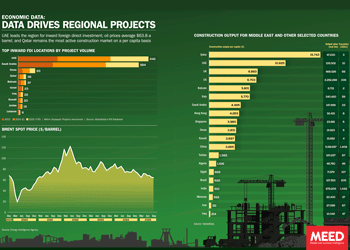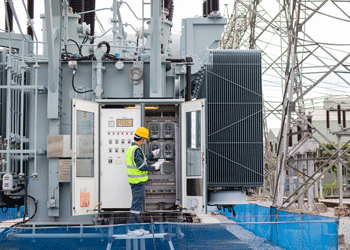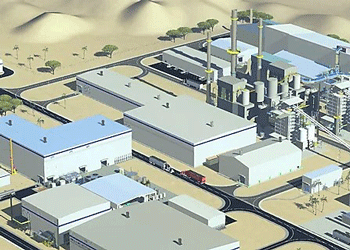Regional downstream sector prepares for consolidation
30 December 2024

The Middle East and North Africa (Mena) region’s midstream and downstream oil, gas and petrochemicals sectors together had one of their best years on record in 2024, with state-owned companies and private players collectively spending close to $38bn on projects.
 Saudi Arabia emerged as the biggest regional spender on midstream and downstream projects. To address incremental volumes of gas entering the grid as Saudi Aramco increases its conventional and unconventional gas production, the state enterprise has spent more than $17bn on gas processing and transportation projects this year.
Saudi Arabia emerged as the biggest regional spender on midstream and downstream projects. To address incremental volumes of gas entering the grid as Saudi Aramco increases its conventional and unconventional gas production, the state enterprise has spent more than $17bn on gas processing and transportation projects this year.
In April 2024, Aramco awarded $7.7bn in engineering, procurement and construction (EPC) contracts for a project to expand the Fadhili gas plant in the Eastern Province of Saudi Arabia. The project is expected to increase the plant’s processing capacity from 2.5 billion cubic feet a day (cf/d) to up to 4 billion cf/d.
On 30 June, Aramco awarded 15 lump-sum turnkey contracts for the third expansion phase of the Master Gas System (MGS-3), worth $8.8bn. Then, in August, the company awarded contracts for the remaining two packages of the MGS-3 project, which were worth $1bn.
Saudi Aramco divided EPC works on the MGS-3 project into 17 packages. The first two packages involve upgrading existing gas compression systems and installing new gas compressors. The 15 other packages relate to laying gas transport pipelines at various locations in the kingdom.
The Master Gas System expansion will increase the size of the network and raise its total capacity by an additional 3.15 billion cf/d by 2028 with the installation of about 4,000 kilometres
of pipelines and 17 new gas compression trains.
 Abu Dhabi capex
Abu Dhabi capex
The UAE has been the second-largest spender on midstream, downstream and chemicals projects in 2024, led by investments from Abu Dhabi National Oil Company (Adnoc) and Taziz – its 60:40 joint venture with industrial holding entity ADQ.
Adnoc’s biggest capital expenditure (capex) was in the form of a $5.5bn EPC contract that it awarded to a consortium of France’s Technip Energies, Japan-based JGC Corporation and Abu Dhabi-owned NMDC Energy to develop a greenfield liquefied natural gas (LNG) terminal complex in Ruwais.
The upcoming Ruwais LNG export terminal will have the capacity to produce about 9.6 million tonnes a year (t/y) of LNG from two processing trains, each of which has a capacity of 4.8 million t/y. When the project is commissioned, Adnoc’s LNG production capacity will more than double to about 15 million t/y.
Adnoc Group subsidiary Adnoc Gas has also advanced a project to expand its sales gas pipeline network across the UAE, which is known as Estidama. The Abu Dhabi-listed company has awarded two EPC packages of the project this year, which together were worth more than $500m.
Adnoc Gas is expected to award the contract for another Estidama package before the end of 2024 that covers the construction of a pipeline that will provide feedstock from its Habshan gas processing plant to the upcoming Ruwais LNG complex.
Taziz, meanwhile, awarded three EPC contracts totalling $2bn for infrastructure works at the industrial chemicals zone that it is developing in Ruwais Industrial City.
Spending to plateau
Having reached a peak in spending, and with EPC contracts awarded for strategic midstream, downstream and chemicals projects in 2024, the Mena region is set to enter a period of more pragmatic project spending in 2025. However, this does not imply that a slump in project capex is likely, and the region could once again equal the level of contract awards made in 2024.
One of the largest projects that may be awarded in 2025 is the main contract for the North Field West LNG project – the third phase of QatarEnergy’s LNG expansion programme.
The North Field West project will have an LNG production capacity of 16 million t/y, which is expected to be achieved through two 8 million t/y LNG processing trains, based on the two earlier phases of QatarEnergy’s LNG expansion programme.
 The new project will draw feedstock for LNG production from the western zone of Qatar’s North Field offshore
The new project will draw feedstock for LNG production from the western zone of Qatar’s North Field offshore
gas reserve.
Taziz is also on course to make progress with the second expansion phase of its derivatives complex, which will more than double the number of chemicals produced at the industrial hub. The expansion’s centrepiece will be a large-scale steam cracker that will supply feedstocks to the several new chemical plants earmarked for third-party investments.
In Saudi Arabia, there has been speculation that Aramco may be revisiting its investment strategy and execution approach for its strategic liquids-to-chemicals programme.
The aim of the programme is to derive greater economic value from every barrel of crude produced in the kingdom by converting 4 million barrels a day (b/d) of Aramco’s oil production into high-value petrochemicals and chemicals feedstocks by 2030.
Aramco has divided its liquids-to-chemicals programme into four main projects. It took a major step forward
in September 2023 by selecting US firm KBR, France’s Technip Energies, UK-based Wood Group and Australia- headquartered Worley to provide project management consultancy services for the four different segments of the scheme.
Progress on a programme as big as the liquids-to-chemicals scheme is expected to be measured and laboured.
While day-to-day the advancement might appear sluggish, Amin Nasser, Aramco’s president and CEO, said earlier in 2024 that the Saudi energy giant is on track to achieve its crude oil-to-chemicals conversion goal by 2030.
“We are on track to achieve our target of 4 million b/d liquids-to-chemicals [conversion capacity] by 2030,” he said.
Meanwhile, Kuwait is in a similar situation with its planned Al-Zour integrated complex upgrade programme (Zicup), which has suffered significant delays in recent years. However, state-owned Kuwait Integrated Petroleum Industries Company (Kipic), the project’s operator, recently appointed a team to look into the logistics of developing a benzine pipeline as part of the estimated $10bn Zicup scheme.
Although this may be a small step, it does indicate that Kuwait remains determined to achieve its ambition of developing a large-scale petrochemicals facility, which, when integrated with its $16bn Al-Zour refinery, could become one of the biggest integrated refining and petrochemicals complexes in the Mena region.

Exclusive from Meed
-
 Navigating financial markets amid geopolitical fragmentation
Navigating financial markets amid geopolitical fragmentation28 December 2025
-
 Oman’s growth forecast points upwards
Oman’s growth forecast points upwards24 December 2025
-
 December 2025: Data drives regional projects
December 2025: Data drives regional projects23 December 2025
-
 Local firm bids lowest for Kuwait substation deal
Local firm bids lowest for Kuwait substation deal22 December 2025
-
 Saudi-Dutch JV awards ‘supercentre’ metals reclamation project
Saudi-Dutch JV awards ‘supercentre’ metals reclamation project22 December 2025
All of this is only 1% of what MEED.com has to offer
Subscribe now and unlock all the 153,671 articles on MEED.com
- All the latest news, data, and market intelligence across MENA at your fingerprints
- First-hand updates and inside information on projects, clients and competitors that matter to you
- 20 years' archive of information, data, and news for you to access at your convenience
- Strategize to succeed and minimise risks with timely analysis of current and future market trends

Related Articles
-
 Navigating financial markets amid geopolitical fragmentation
Navigating financial markets amid geopolitical fragmentation28 December 2025

As we move towards 2026, geopolitical fragmentation is no longer a background risk that occasionally disrupts markets.
It has become a defining feature of the global financial landscape. Shifting alliances, persistent regional tensions, sanctions and the reconfiguration of supply chains are reshaping how capital flows, how liquidity behaves and how confidence is formed.
For firms operating in the Middle East, this does not simply mean preparing for more volatility. It means operating in a system where the underlying rules are evolving.
For much of the past three decades, businesses and investors worked within a broadly convergent global framework. Trade expanded, financial markets deepened and policy coordination – while imperfect – created a sense of predictability. That environment has changed.
Today, economic decisions are increasingly influenced by strategic alignment, security considerations and political resilience. Markets still function, but they do so in a more fragmented and less forgiving way.
Shifting landscape
One of the most important consequences of this shift is that risk no longer travels along familiar paths. In the past, geopolitical events were often treated as temporary shocks layered onto an otherwise stable system.
Today, they shape the system itself. Trade flows are influenced as much by political compatibility as by cost efficiency. Supply chains, once optimised for speed and scale, are reorganising into regional or allied clusters. Financial markets respond not only to data, but to narratives about stability, alignment and long-term credibility.
This change places greater pressure on firms that rely on historical relationships to guide decisions. Models built on past correlations – between interest rates and equity markets, or between energy prices and regional growth – are less reliable when markets move between different regimes. The challenge is not simply higher volatility, but the fact that correlations themselves can shift quickly.
Monetary policy adds a second layer of complexity. Major central banks are no longer moving in step. The US, Europe and parts of Asia face different inflation dynamics and political constraints, leading to diverging interest-rate paths.
For the GCC, where currencies are largely pegged to the US dollar, this divergence has direct consequences. Local financial conditions are closely tied to decisions taken by the Federal Reserve, even when regional economic conditions follow a different cycle.
This matters because funding costs, liquidity availability and hedging conditions are shaped by global rather than local forces. When US policy remains tight, dollar liquidity becomes more selective. When expectations shift abruptly, market depth can disappear quickly.
For firms with international exposure, long-term investment plans, or reliance on external financing, these dynamics require careful management. They cannot be treated as secondary macro considerations.
Energy markets further complicate the picture. The Middle East remains central to global energy supply, which means geopolitical events often interact with oil prices and financial conditions at the same time.
When shifts in energy expectations coincide with changes in global interest-rate sentiment, liquidity conditions can tighten rapidly. This interaction is well known in academic research on fixed exchange-rate systems, but its practical implications are often underestimated in corporate planning.
Expanding vulnerabilities
These dynamics expose clear vulnerabilities. Concentrated supply chains are more susceptible to disruption. Financing structures dependent on continuous market access are more exposed to sudden repricing. Risk management approaches that assume stable relationships between assets are more likely to disappoint. Operational risks – particularly in technology and data – are increasingly shaped by geopolitical considerations rather than purely technical ones.
At the same time, the region enters 2026 from a position of relative strength. GCC economies benefit from fiscal buffers, long-term investment programmes and a growing perception of stability compared to other parts of the world. In an environment where uncertainty is widespread, predictability itself becomes valuable. Capital increasingly seeks jurisdictions that combine economic ambition with institutional credibility.
The question, therefore, is not whether opportunities exist, but whether firms are prepared to capture them responsibly. This requires a shift in how future risks are assessed and embedded into decision-making. Linear forecasts and static plans are insufficient when the environment itself can change state. Scenario thinking must evolve beyond optimistic and pessimistic cases to reflect different combinations of geopolitical alignment, monetary conditions, and supply-chain stability. These scenarios should inform capital allocation, not sit in strategy documents.
Liquidity and risk management discipline also become central. In both trading and corporate finance, experience shows that many failures stem not from being wrong on direction, but from being overexposed when conditions change. Scaling risk to market conditions, maintaining funding flexibility and understanding how quickly liquidity can evaporate are essential practices. This is as true for corporate balance sheets as it is for trading books.
Operational resilience must be viewed through the same lens. Supply-chain redundancy, cybersecurity preparedness and data governance are no longer purely operational concerns. They influence financial stability, investor confidence and regulatory trust. In a fragmented world, operational disruptions can quickly translate into financial and reputational damage.
Facing the future
As we approach 2026, leadership in the Middle East faces a clear test. The global environment is unlikely to become simpler or more predictable. Firms that continue to rely on assumptions shaped by a different era will find themselves reacting rather than positioning. Those that invest in disciplined risk management, flexible planning and operational resilience will be better placed to navigate uncertainty and to turn volatility into strategic advantage.
In this environment, risk management is not an obstacle to growth. It is the framework that makes sustainable growth possible.
Ultimately – and this is an often overlooked critical point – none of these adjustments, whether in scenario planning, liquidity discipline, or operational resilience, can be effective without the right human capital in place.
Geopolitical fragmentation and financial volatility are not risks that can be fully addressed through models or policies alone. They require informed judgement, institutional memory and the ability to interpret weak signals before they become material threats or missed opportunities.
Firms that succeed in this environment will be those that deliberately invest in corporate knowledge: building internal capabilities where possible and complementing them with external expertise where necessary. This means involving professionals with the right background, cross-market experience and a proven, proactive approach to risk awareness and governance.
In a fragmented world, competitive advantage increasingly depends not only on capital or strategy, but on the quality of people entrusted with understanding risk, challenging assumptions and guiding decision-making under uncertainty.
 https://image.digitalinsightresearch.in/uploads/NewsArticle/15306336/main.gif
https://image.digitalinsightresearch.in/uploads/NewsArticle/15306336/main.gif -
 Oman’s growth forecast points upwards
Oman’s growth forecast points upwards24 December 2025

MEED’s January 2026 report on Oman includes:
> COMMENT: Oman steadies growth with strategic restraint
> GVT & ECONOMY: Oman pursues diversification amid regional concerns
> BANKING: Oman banks feel impact of stronger economy
> OIL & GAS: LNG goals galvanise Oman’s oil and gas sector
> POWER & WATER: Oman prepares for a wave of IPP awards
> CONSTRUCTION: Momentum builds in construction sectorTo see previous issues of MEED Business Review, please click herehttps://image.digitalinsightresearch.in/uploads/NewsArticle/15306449/main.gif -
 December 2025: Data drives regional projects
December 2025: Data drives regional projects23 December 2025
Click here to download the PDF
Includes: Top inward FDI locations by project volume | Brent spot price | Construction output
MEED’s January 2026 report on Oman includes:
> COMMENT: Oman steadies growth with strategic restraint
> ECONOMY: Oman pursues diversification amid regional concerns
> BANKING: Oman banks feel impact of stronger economy
> OIL & GAS: LNG goals galvanise Oman’s oil and gas sector
> POWER & WATER: Oman prepares for a wave of IPP awards
> CONSTRUCTION: Momentum builds in construction sectorTo see previous issues of MEED Business Review, please click herehttps://image.digitalinsightresearch.in/uploads/NewsArticle/15306140/main.gif -
 Local firm bids lowest for Kuwait substation deal
Local firm bids lowest for Kuwait substation deal22 December 2025
The local Al-Ahleia Switchgear Company has submitted the lowest price of KD33.9m ($110.3m) for a contract to build a 400/132/11 kV substation at the South Surra township for Kuwait’s Public Authority for Housing Welfare (PAHW).
The bid was marginally lower than the two other offers of KD35.1m and KD35.5m submitted respectively by Saudi Arabia’s National Contracting Company (NCC) and India’s Larsen & Toubro.
PAHW is expected to take about three months to evaluate the prices before selecting the successful contractor.
The project is one of several transmission and distribution projects either out to bid or recently awarded by Kuwait’s main affordable housing client.
This year alone, it has awarded two contracts worth more than $100m for cable works at its 1Z, 2Z, 3Z and 4Z 400kV substations at Al-Istiqlal City, and two deals totalling just under $280m for the construction of seven 132/11kV substations in the same township.
Most recently, it has tendered two contracts to build seven 132/11kV main substations at its affordable housing project, west of Kuwait City. The bid deadline for the two deals covering the MS-01 through to MS-08 substations is 8 January.
https://image.digitalinsightresearch.in/uploads/NewsArticle/15305745/main.gif -
 Saudi-Dutch JV awards ‘supercentre’ metals reclamation project
Saudi-Dutch JV awards ‘supercentre’ metals reclamation project22 December 2025
The local Advanced Circular Materials Company (ACMC), a joint venture of the Netherlands-based Shell & AMG Recycling BV (SARBV) and local firm United Company for Industry (UCI), has awarded the engineering, procurement and construction (EPC) contract for the first phase of its $500m-plus metals reclamation complex in Jubail.
The contract, estimated to be worth in excess of $200m, was won by China TianChen Engineering Corporation (TCC), a subsidiary of China National Chemical Engineering Company (CNCEC), following the issue of the tender in July 2024.
Under the terms of the deal, TCC will process gasification ash generated at Saudi Aramco’s Jizan refining complex on the Red Sea coast to produce battery-grade vanadium oxide and vanadium electrolyte for vanadium redox flow batteries. AMG will provide the licensed technology required for the production process.
The works are the first of four planned phases at the catalyst and gasification ash recycling ‘Supercentre’, which is located at the PlasChem Park in Jubail Industrial City 2 alongside the Sadara integrated refining and petrochemical complex.
Phase 2 will expand the facility to process spent catalysts from heavy oil upgrading facilities to produce ferrovanadium for the steel industry and/or additional battery-grade vanadium oxide.
Phase 3 involves installing a manufacturing facility for residue-upgrading catalysts.
In the fourth phase, a vanadium electrolyte production plant will be developed.
The developers expect a total reduction of 3.6 million metric tonnes of carbon dioxide emissions a year when the four phases of the project are commissioned.
SARBV first announced its intention to build a metal reclamation and catalyst manufacturing facility in Saudi Arabia in November 2019. The kingdom’s Ministry of Investment, then known as the Saudi Arabian General Investment Authority (Sagia), supported the project.
In July 2022, SARBV and UCI signed the agreement to formalise their joint venture and build the proposed facility.
The project has received support from Saudi Aramco’s Namaat industrial investment programme. Aramco, at the time, also signed an agreement with the joint venture to offtake vanadium-bearing gasification ash from its Jizan refining complex.
Photo credit: SARBV
https://image.digitalinsightresearch.in/uploads/NewsArticle/15305326/main.gif

